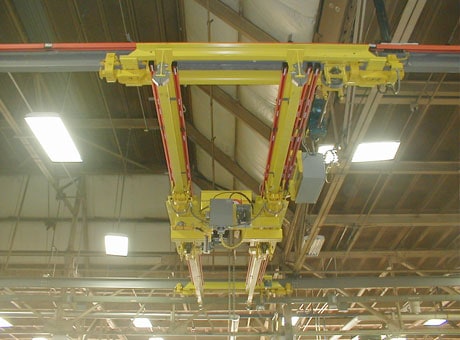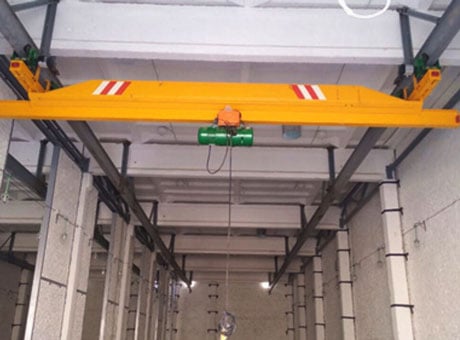1. Basic components of underhung overhead crane
The industry electric underhung overhead crane includes annual operating mechanism, lifting trolley, driver’s cab, electrical system and safety protection devices, etc.
(1) The bridge frame includes the main beam, which is a load-bearing beam, and the trolley track is fixed on the main beam. The main beam should have an upper camber. After my test, when the smaller main car is in the extreme position, the highest point of the upper camber should be within the range of S/10 (S is the span) in the middle of the span, and its value should not be less than 0.7S/1 000. End beams are components that support bridge beams and are composed of plate beams, trusses, wheel sets, etc.
(2) The operating mechanism of the cart includes motors, reducers, brakes, transmission shafts, couplings and wheels, etc., which are used to drive the wheels of the cart to rotate and run horizontally along the crane track.
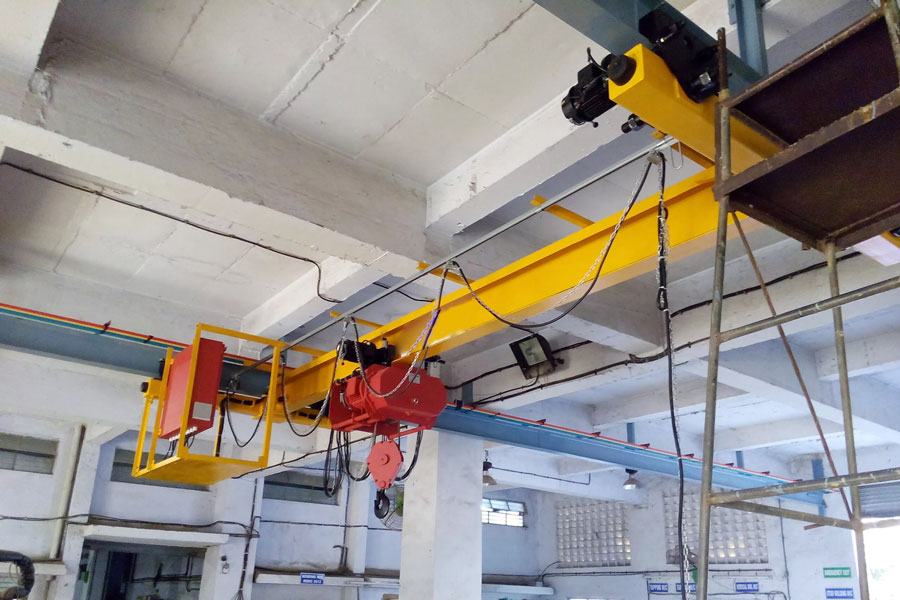
(3) The lifting trolley is an assembly that moves the hanging load. It consists of the trolley operating mechanism, the lifting mechanism and the trolley frame. The trolley operating mechanism is mainly composed of motors, reducers, brakes, transmission shafts, couplings and wheels, and is responsible for the lateral movement of the crane; the lifting mechanism is composed of motors, reducers, brakes, drums, fixed pulleys and lifting wire ropes, etc. It is composed of a small frame and is responsible for the lifting movement of lifting operations; the trolley frame is generally composed of steel plates and section steel welded to bear and transmit all lifting loads.
(4) All control equipment of the crane as well as signaling and lighting equipment are installed in the cab, which are controlled by the driver.
(5) The overhead crane uses slide wires and brushes for power supply. The three-phase AC power supply is connected to the main slide line erected along the length of the trolley track. It is first introduced to the main power switch in the cab through the brush, and then supplies power to various electrical equipment of the crane. The trolley is powered by the auxiliary slide line. Small cranes are powered by flexible cables.
(6) The installation requirements of safety protection devices on bridge cranes are as follows: The safety protection devices that should be installed include lifting weight limiter, lifting height limiter, descent depth limiter (as needed), and operating stroke limiter. , interlocking protection safety devices, buffers, wind-resistant anti-skid devices (for outdoor work), track cleaners, end stops, conductive slide wire protection plates, protective covers for movable parts of the basket, rain protection for electrical equipment (When the protection level for outdoor work cannot meet the requirements), the safety protection devices that should be installed include operation alarm devices and anti-collision devices.
2. Working characteristics and uses of SEVENCRANE underhung overhead crane
The working space of the heavy duty underhung overhead crane is a box-shaped space with a fixed span, which does not occupy the usable area of the ground.
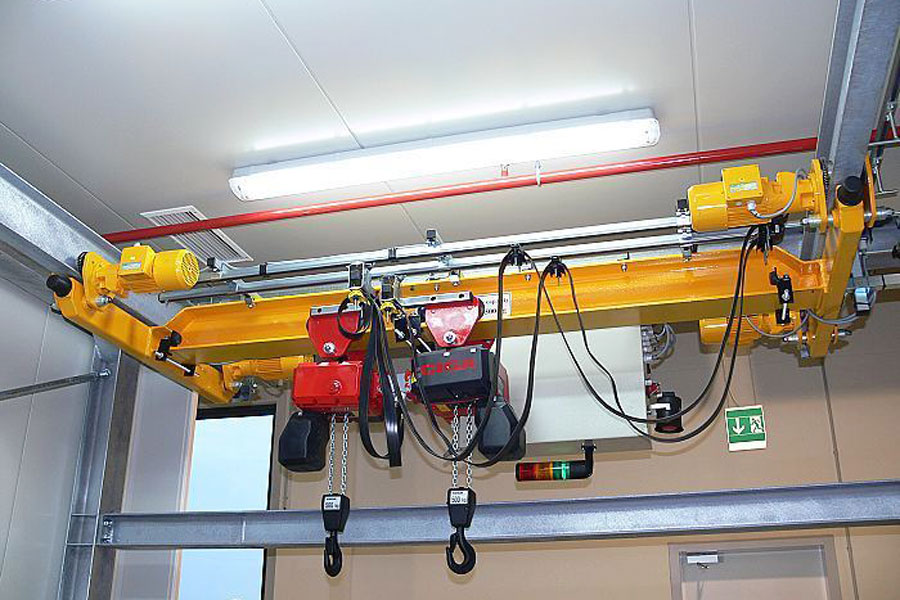
Underhung overhead crane with complete runways are mainly used for the transportation of materials in indoor machinery manufacturing and processing workshops, assembly workshops, warehouses, material yards, for lifting fixed maintenance equipment such as power plants, and other occasions. They can also be used in metallurgy and casting workshops as auxiliary lifting equipment. Besides, it is not suitable for flammable, explosive, combustible gas, dust and corrosive gas environments. However, it is not suitable for nuclear radiation environment and toxic gas environment.
3. Working environmental conditions requirements for underhung overhead cranes
(1) The power supply of the crane is three-phase alternating current (three-phase four-wire system), the frequency is 50Hz or 60Hz, and the voltage is generally ≤ 1kV (it can also be 3 kV, 6 kV or 10 kV as needed). The voltage fluctuation of the power supply system at the connection point of the crane feeder line should be within ±10% of the rated voltage, and the internal voltage loss of the crane should comply with the provisions of the “Code for Crane Design” (GB/T3811-2008).
(2) The track installation of the crane operation should meet the level 2 tolerance requirements in Table 2-1 (when the crane operating speed ≥ 112 m/min, the track installation should meet the level 1 tolerance requirements).
(3) The grounding resistance value of the crane operating track should not be greater than 4 Q (the user is responsible).
(4) The altitude where the crane is installed and used should not exceed 1000 m. When the length exceeds 1000 m, the capacity of the motor should be checked in accordance with the provisions of “Rotating Electrical Machines – Ratings and Performance” (GB/T 755-2019); when the length exceeds 2000 m, the capacity of the electrical devices should be checked.
(5) The radiant heat temperature of the crane hook part caused by the lifted items should not exceed 300 ℃.
(6) The climate conditions when the crane is working indoors are as follows:
a. The ambient temperature does not exceed 40 ℃, and the average temperature within 24 hours does not exceed 35 ℃.
b. The ambient temperature is not lower than -5 ℃.
c. At a temperature of 40°C, the relative humidity does not exceed 50%.
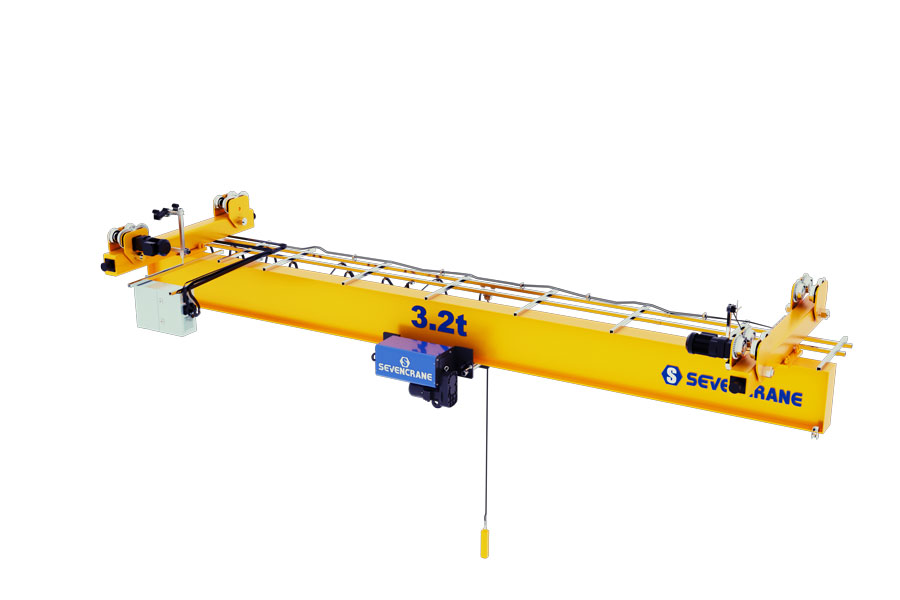
(7) The climatic conditions when the crane is working outdoors are as follows:
a. The ambient temperature does not exceed 40 ℃, the average temperature within 24 hours does not exceed 35 ℃, and the ambient temperature is not lower than -20 ℃. 2) When the ambient temperature does not exceed 25 ℃, the relative humidity is allowed to temporarily reach 100%.
b. The working wind pressure should not be greater than: 150 Pa (equivalent to level 5 wind) inland and 250 Pa (equivalent to level 6 wind) along the coast.
c. The maximum wind pressure in non-working state is generally 800 Pa (equivalent to level 10 wind), which can also be agreed separately.
(8) The operating conditions of the electric motor should comply with the relevant regulations in “Rotating Electrical Machines Ratings and Performance” (GB/T 755-2019).
(9) The normal use, installation and operating conditions of electrical appliances should comply with the relevant regulations in “Low-voltage switchgear and control equipment Part 1: General Provisions” (GB 14048.1-2012).









